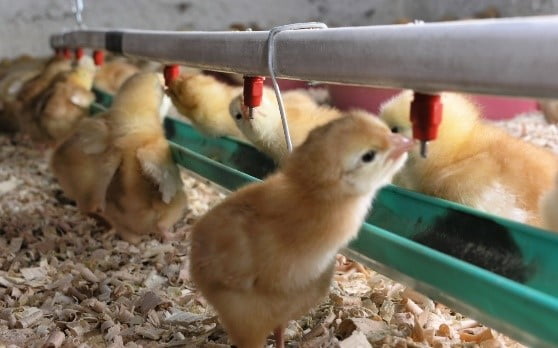Factors Affecting Water Intake in Poultry

Dr. Ajay K
Kemin Industries South Asia Pvt. Ltd.
[su_heading align=”left”]Introduction[/su_heading]
Water is the most important nutrient for the overall health and performance of poultry. Water plays a vital role in metabolism, regulation of birds’ body temperature, food digestion and waste elimination. By weight, poultry consumes almost twice as much water as feed in normal conditions. There are many factors which affect water intake and results in less profitable farming. Hence, monitoring the factors affecting the water intake will help in more profitable business by efficient water management.
A) Diet Composition
• Crumble and pelleted diet results in more feed intake and more water intake when compared to mash feed.
• More crude protein in feeds: Higher level of potassium (K) and soluble oligosaccharides from soybean (vegetable diet) results 13% higher water intake when compared to non vegetable diet as protein source.
• More salt in feed: Daily water intake is increased by 13.5 ml/g of sodium (Na) added in the diet.
• Dietary nutrient contents in excess to the animals requirements will have a higher impact on water intake than on feed intake, as water is the vehicle for excretion of excess nutrients via kidney.
• Nature of dietary fiber: For example, adding citrus pectin as a soluble fermentable fiber (soluble non-starch polysaccharide -NSP) and high level of barley stimulated water intake, but adding oat hulls as inert fiber results in lower water intake.
• Linoleic acid deficiency results in the loss of membrane integrity. An increased need for water and decreased resistance to diseases are the characteristic deficiency symptoms observed in poultry.
• Lowering dietary energy results in more feed consumption and increased water intake.
B) Environmental Factors & Stress
• High Temperature (Heat Stress) – Chickens drink around 30-50% more water when the environmental temperature is above 32oC than the temperature at 21oC.
• Very low temperature of sheds results in less water intake as huddling take place.
• Increased intestinal viscosity leads to reduced sodium and water absorption from the intestinal tract, consequently resulting in increased daily water intake.
• Physiological stress and adrenocorticotropic hormone (ACTH) infusion causes mobilization of muscle protein, gluconeogenesis in stress, increased uric acid formation and more water excretion, thus resulting in increased water intake by birds for homeostasis.
• Layers drink relatively more water just after laying eggs as they loose 40g water per egg.
C) Managemental Conditions
• Blocked nipple line results in lower intake of water.
• When lights are turned on in sheds at 5 AM and 8 PM, birds tend to reach drinkers and consume water.
• Types of drinkers and number of drinkers: Total water intake was observed to be 7.55 times higher in bell drinkers (28.11 ml) when compared to nipple (3.72 ml).
• Birds on restricted feeding program consume more water to feel full than usual.
• Higher stocking density increases water consumption.
• Less number of drinkers and less feeding space results in lower intake of water.
• Weak, lame and emaciated birds often consume less water.
• Birds drink water when there is a movement in shed by farm personnel.
D) Specific Toxicosis
• Birds affected with ochratoxicosis consume more water.
• Oosporein and Citrinin toxicity results in increased water consumption of birds.
E) Infectious Conditions
• Birds consume more water during infections like necrotic enteritis, reo viral infection, avian influenza (AI), new castle disease (NCD) and infectious bursal (IB) disease.
• Coccidial infection reduces water intake during acute disease.
F) Antimicrobials Use
• Sulpha drug treatment and poisoning increases water consumption.
• Some ionophorous anticoccidials like Lasalocid and Maduramycin will stimulate water consumption.
• Water treated with tiamulin powder is relatively bitter in taste, which may result in less water intake.
G) Water related factors
• Excess hot or cold water results in less water intake.
• Excess minerals in water reduces water intake.
• Reduced water consumption is seen when the pH of water is less than 4.
• Fresh water attract birds to consume more water, while dirty water (from litter, feather and vomiting) limits water intake.
NOTE:
• Excessive water intake can be indicative of gut health issues.
• Using water acidifiers and sanitizers like AcidLAC™ W on regular basis ensures wholesome drinking water.
• Routine on-farm recording of water intake is a key management practice, which can help to identify potential health or management issues.
• The above points can be considered to alleviate the wet litter condition.
[su_divider style=”dashed” size=”5″]



